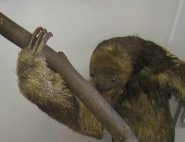 The Maned three-toed Sloth (Bradypus torquatus) is a sloth that comes from South America and is related to the other three-toed sloths of the South American variety. The Maned Sloth is about 50 centimeters in length (19 inches) and weighs about 4.5 kilograms (or 10 pounds). Unusual is its proportions of body parts, with very small eyes, small ears, and a tail that is hidden from view, along with a small head. Their fur is of interest as it has a fine undercoating of fur, but atop that is the outer coating which is a virtual ecosystem in its own right. The outer coating is usually infested and inhabited by moths, beetles, ticks, mites, algae and moss.
The Maned three-toed Sloth (Bradypus torquatus) is a sloth that comes from South America and is related to the other three-toed sloths of the South American variety. The Maned Sloth is about 50 centimeters in length (19 inches) and weighs about 4.5 kilograms (or 10 pounds). Unusual is its proportions of body parts, with very small eyes, small ears, and a tail that is hidden from view, along with a small head. Their fur is of interest as it has a fine undercoating of fur, but atop that is the outer coating which is a virtual ecosystem in its own right. The outer coating is usually infested and inhabited by moths, beetles, ticks, mites, algae and moss. The Maned three-toed sloth belongs to the genus Bradypus, which has only four other species of three toed sloths and most are threatened or endangered. Bradypus belongs to the family of Bradypodidae, which has no other members but the genus Bradypus. Bradypodidae belongs to the suborder Folivora, which is the sloth in general, as it contains only one other family - Megalonychidae, or two-toed sloths. The full order than Folivora belongs to is called Pilosa, which also only has one other suborder - Vermilingua, otherwise known as anteaters.
The diet of the Maned three-toed sloth is that of an omnivore, eating buds off of trees or insects that happen to come its way.
Gestation (pregnancy) lasts for five to six months, and then the young sloth will cling to its mother for the first four weeks of its life, gripping with its already highly developed claws. After the suckling is finished it will remain with its mother, usually riding on her back, for up to six months to learn the habits and feeding styles of the adult. Eventually it will venture out on its own, where it can live for up to twelve years in the wild - barring it being cut down with a tree or shot by poachers for its meat or as a trophy.
The Maned three-toed Sloth is an endangered species, and is close to being listed as Critically Endangered, mostly due to deforestation and destruction of its natural habitat. Due to the mass slash and burn policies to create land for farming or grazing cattle the Maned three-toed Sloth is now restricted to only a few habitats, one being in Brazil, and spread around the areas surrounding northern Brazil. To compound this problem, the sloth is generally hunted for meat or trophy sport, creating a spiral of de-population that could soon make the species extinct.
Some interesting facts about the Maned three-toed Sloth
- Due to its ‘upside down’ lifestyle the Maned three-toed Sloth has fur that is ‘backwards’ in that instead of being directed from the back down to the abdomen, it is directed from the abdomen to the back.
- Sloths are related to Anteaters, and also because they are in a super-order (Xenartha) they are related to armadillos, the extinct glyptodonts (super armadillos), the extinct pampatheres (giant armadillos) and several extinct sloth species (including the ground sloth that may have gone extinct in 1500 AD, and the giant sloths that grew taller than 17 feet).
The Maned sloth, maned three-toed sloth is listed as Endangered (EN), considered to be facing a very high risk of extinction in the wild, on the IUCN Red List of Threatened Species
Countries
BrazilManed three-toed sloth habitats
Forest, Subtropical / Tropical Dry forest and Subtropical / Tropical Moist Lowland
Custom Search